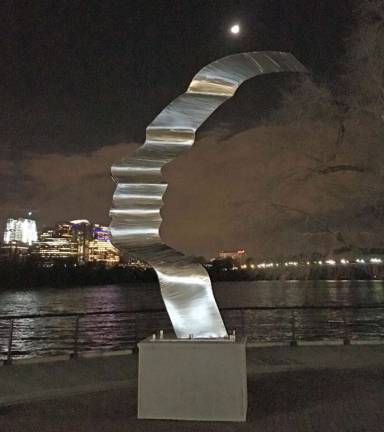Enough tears



How about a giant climate celebration?
By Heather Ingram
I arrive a few minutes early for our interview to find Barton Rubenstein swinging in a hammock. He apologized for not greeting me at his studio door, but “I couldn’t help myself,” he said. “It’s just such a perfect day.” An entirely appropriate response from the artist behind the Mother Earth Project.
I’d met Rubenstein the week before at the Georgetown waterfront, at the dedication of Mother Earth, a 14-foot tall steel sculpture that, depending on where you stand, either looks like a person’s profile gazing serenely down the Potomac or a giant metal ribbon undulating in the wind. The Mother Earth Project was conceived as a way to incentivize countries to take part in reversing climate change. Participating countries place the Mother Earth statue in a major city, a symbol of their commitment to achieving environmental sustainability – and an ideal meet-up spot for environmental actions. The second sculpture is expected to go up in Jerusalem this summer.
One of the challenges with addressing climate change is the global scale: the problem can be so overwhelming it feels impossible to make any difference. Rubenstein knows the feeling.
“My family has been environmentally aware, beginning in the 70s,” Rubenstein said. “We recycled, composted, even used solar panels. It was a full family act.” His sister, who lives in San Francisco, “coached him” on ways to reduce his family’s waste from three bags a week to one small grocery bag. Eventually he helped to make his neighborhood a composting pioneer in Silver Spring, Maryland. But still, to Rubenstein, his wife and three teenage kids, the impact felt miniscule.
As it happened, in 2015, the Smithsonian’s National Portrait Gallery commissioned Rubenstein – a sculptor known internationally for his big, public pieces – to create a statue. Rubenstein eventually alighted on using the profile of his own mother, as a way to honor all mothers. Just before the piece was to be installed, the gallery changed direction, requesting instead the design be miniaturized, to be turned into what is now the Portrait of a Nation prize which has been awarded to such notables as Aretha Franklin, Maya Lin and Hank Aaron. This left Rubenstein with a one-and-a-half story statue and no place to put it.
A bit too large to be a lawn ornament, it also felt like there was a big opportunity there. The answer emerged when his son had the idea to place the statue on all five continents. With the 2015 ratification of the Paris Agreement by 196 countries, it felt like the world was ready for such an ambitious project. Rubenstein began reaching out to embassies, literally down the street, and found that each one had an environmental champion.
Things have gotten more complicated since the election, as our own government considers ditching the Paris Accord. But whatever happens, the exhibition will go on, a powerful and newly political symbol.
Rubenstein shows me the Humans of Mother Earth Instagram, part of the project that has been taken over by his daughter Sabrina, 18. It’s filled with photos from all over the world of people celebrating environmental successes big and small, like a Maryland middle schooler’s art project: a monarch butterfly painted onto a parachute that kids carried at the Peoples Climate March in D.C. Next he shows me the Mother Earth Project Hall of Achievement, highlighting positive changes by country, from Afghanistan’s work to stop illegal logging to Zambia’s green jobs initiative.
The Mother Earth project is the beginning of a conversation that’s rare these days. Instead of mourning what’s lost or pointing fingers, this is a celebration of what we’re doing right. Whether it’s a teacher intentionally turning off the lights after a class, a little girl picking up a piece of litter on the playground, or a friend biking to work every day, there is something profoundly powerful that happens when we stand up together.